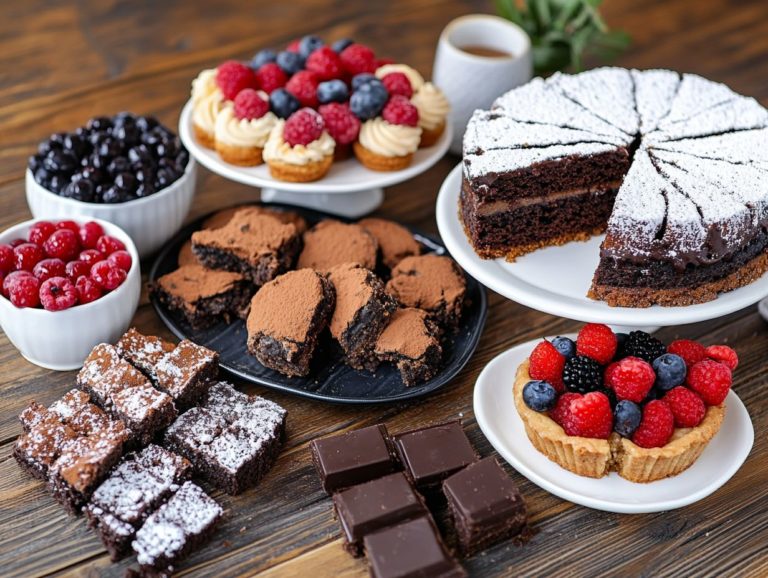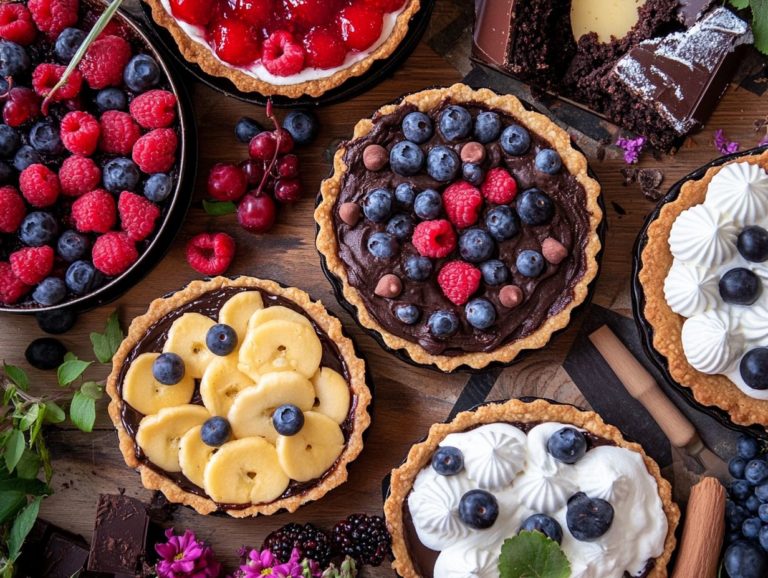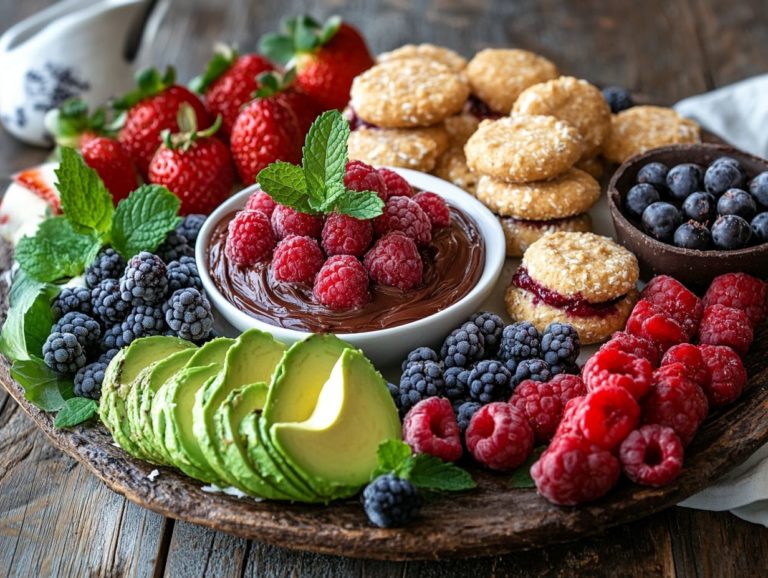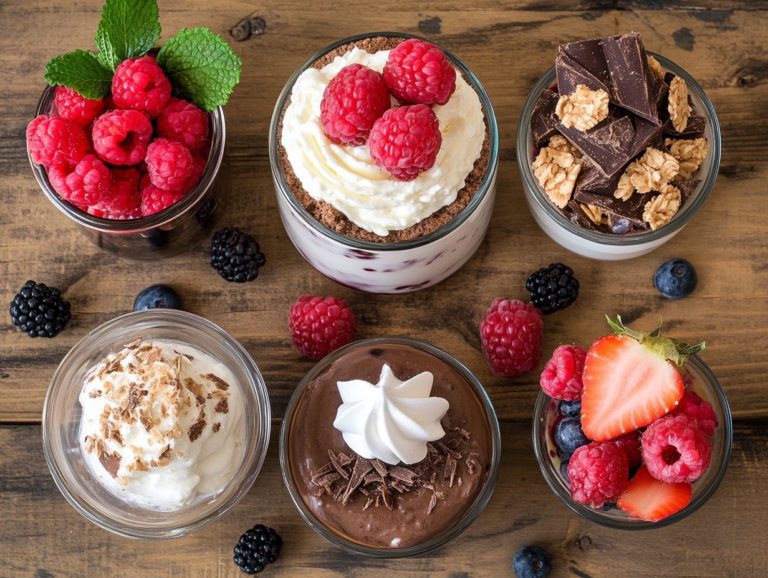Gluten-Free Desserts: Tricks for Better Taste
In recent years, gluten-free diets have gained attention, attracting not only those with celiac disease but also a growing number of health-conscious individuals. This trend has inspired many to delve into the potential benefits of adopting a gluten-free lifestyle, such as reduced inflammation and enhanced digestive health.
However, it’s important to recognize that misconceptions surrounding gluten-free eating can often create confusion. If you’re eager to discover how to transform gluten-free desserts into delightful treats, this article offers valuable tips and insights designed to elevate your gluten-free baking experience.
Contents
- Key Takeaways:
- What Are The Benefits Of Gluten-Free Diet?
- What Are The Common Misconceptions About Gluten-Free Diet?
- Common Misconceptions about Gluten-Free Diets
- How Can You Make Gluten-Free Desserts Taste Better?
- 2. Incorporate Fruits and Vegetables
- 3. Experiment with Different Sweeteners
- 4. Add Flavorful Spices and Herbs
- 5. Try Different Cooking Methods
- Frequently Asked Questions
- What is the main trick for making gluten-free desserts taste better?
- Can I use regular recipes and simply substitute gluten-free ingredients?
- Are there any specific types of gluten-free flour that work best for desserts?
- How can I add more flavor to my gluten-free desserts?
- Do I need to make any adjustments to baking time or temperature when making gluten-free desserts like gluten-free cake or gluten-free cookies?
- Are there any other tips for making gluten-free desserts taste better and have great flavors?
Key Takeaways:

- Incorporate alternative flours and experiment with different sweeteners to make gluten-free desserts taste better.
- Adding flavorful spices and herbs can enhance the taste of gluten-free desserts.
- Don’t believe the misconceptions that gluten-free always means healthy or that it’s just a fad – it can help manage celiac disease and improve digestive health.
What Are The Benefits Of Gluten-Free Diet?
The gluten-free diet has gained attention recently, primarily because of its potential advantages for those with Celiac Disease and individuals aiming to reduce inflammation, enhance digestive health, and even facilitate weight loss. By cutting out gluten a protein found in wheat, barley, and rye you may discover a remarkable transformation in your overall well-being if you have gluten sensitivity.
The growing popularity of gluten-free desserts and recipes means you can easily explore these options without sacrificing flavor or enjoyment.
1. Helps Manage Celiac Disease
For those diagnosed with Celiac Disease, maintaining a strict gluten-free diet is essential for effectively managing the condition and preventing serious health complications. Celiac Disease is an illness that causes your immune system to react negatively to gluten, resulting in inflammation and damage to the small intestine. You must avoid gluten-containing foods, which requires careful selection of gluten-free options and a thorough understanding of gluten-free ingredients.
The repercussions of consuming gluten can range from uncomfortable bloating and diarrhea to more severe complications, such as nutrient malabsorption and an elevated risk of other autoimmune disorders. Steering clear of gluten isn’t just important; it s a game-changer for your health!
By emphasizing gluten-free choices, you can significantly enhance your quality of life, enjoying a variety of delicious alternatives like quinoa, rice, and gluten-free oats, alongside products from trusted brands like Bob’s Red Mill and Glutino.
These options are not only safe but also cater to a wide range of tastes, ensuring that you don’t feel deprived while nourishing your body with wholesome and safe foods.
2. Reduces Inflammation
Many individuals who eliminate gluten from their diets find a remarkable reduction in inflammation-related symptoms, such as joint pain, bloating, and fatigue. If you happen to be sensitive to gluten, you might discover that ditching it can significantly ease these issues.
Adopting a gluten-free diet allows you to focus on whole, unprocessed foods packed with anti-inflammatory properties. This dietary shift encourages you to embrace fresh fruits, vibrant vegetables, and alternative grains.
Beyond just alleviating discomfort, a gluten-free diet invites you to include nourishing foods renowned for their anti-inflammatory benefits. For example, consider incorporating quinoa, brown rice, and amaranth as fantastic substitutes for gluten-containing grains. These options provide a wealth of fiber and antioxidants that can elevate your meals.
Imagine whipping up a quinoa salad brimming with colorful vegetables and a drizzle of simple olive oil dressing; not only does it offer ample nutrition, but it also actively supports a reduction in inflammation.
Integrating anti-inflammatory staples like turmeric and ginger into your dishes can amplify their health benefits. These flavorful ingredients transform your meals into soothing, health-promoting experiences, allowing you to enjoy the culinary delights without the adverse effects that gluten may impose on those with sensitivities.
3. Improves Digestive Health
Switching to a gluten-free diet can lead to remarkable enhancements in your digestive health, especially if you have gluten sensitivity or intolerance. Removing gluten from your meals often alleviates pesky symptoms like bloating, gas, diarrhea, and constipation, ultimately fostering a healthier gut. Many gluten-free ingredients are naturally packed with fiber, boosting your digestive function and fitting beautifully into a range of delicious gluten-free recipes.
Imagine enjoying delicious foods like quinoa, brown rice, and legumes not only do they deliver essential nutrients, but they also help support a healthy digestive tract by promoting regularity. A hearty quinoa salad brimming with vibrant vegetables or a warming lentil soup can be both satisfying and beneficial for maintaining optimal digestion.
Don t overlook other fiber-rich gems like chia seeds and almonds; they can easily be blended into smoothies or sprinkled atop your yogurt for an extra nutritional kick. By focusing on these nutrient-dense ingredients, you can craft satisfying meals that enhance your overall well-being while effortlessly steering clear of gluten!
4. May Aid in Weight Loss
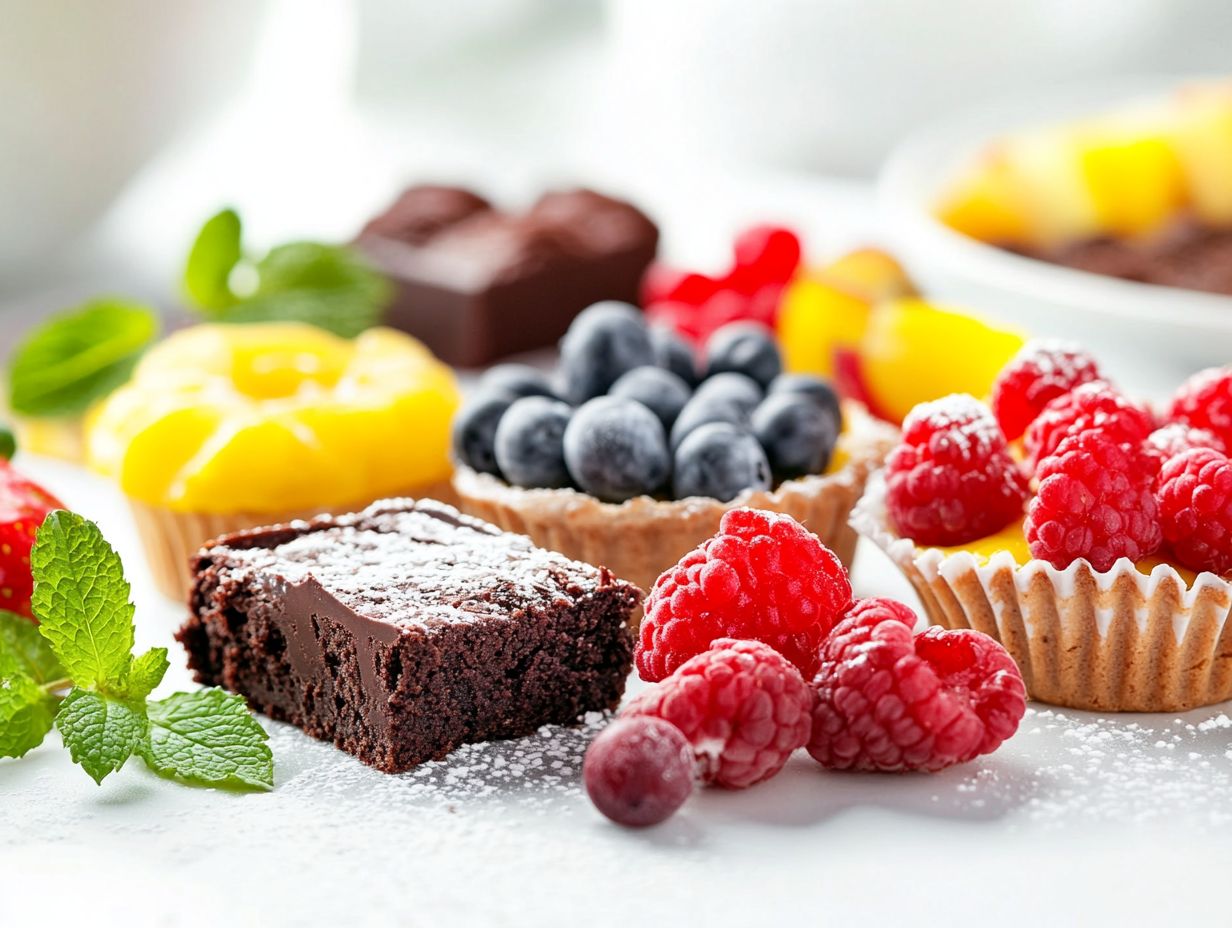
A gluten-free diet might just be the key to weight loss, primarily because it often encourages healthier eating habits that naturally come with cutting out gluten. By concentrating on whole foods and gluten-free options, you’re likely to consume fewer processed foods laden with sugars and unhealthy fats. Delightful gluten-free desserts and snacks crafted from wholesome ingredients can satisfy your cravings without tipping the scales with excess calories.
This shift in your dietary patterns encourages the incorporation of nutritious foods think vibrant fruits, colorful vegetables, lean proteins, and wholesome grains like quinoa and brown rice. These naturally gluten-free options are generally lower in calories, making it easier for you to maintain a healthy weight.
This journey fosters a mindset of mindful eating, which promotes portion control and sensible indulgence. Imagine enjoying a homemade almond flour cookie studded with dark chocolate; it s a delightful treat that adheres to gluten-free principles while allowing you to indulge occasionally without the guilt of overloading on calories.
Adopting this balanced approach can not only lead to weight loss but also enhance your overall well-being.
What Are The Common Misconceptions About Gluten-Free Diet?
Even with the rising popularity of gluten-free diets, several misconceptions linger, creating confusion about what it genuinely means to eat gluten-free. You might think that all gluten-free products are automatically healthy, but that s not the case.
Not every gluten-free option is made equal; some may be processed foods loaded with sugar and unhealthy fats. It s essential for you to distinguish between safe gluten-free choices for individuals with a serious condition that makes you sick if you eat gluten and those opting for a gluten-free lifestyle for various other reasons.
Common Misconceptions
One major misconception you might encounter is the belief that gluten-free automatically means healthier eating. This can lead you to opt for gluten-free products without truly considering their nutritional content.
While gluten-free items are crucial for those with gluten sensitivities, many of these products are often highly processed and packed with sugars or unhealthy fats, which can undermine any potential health benefits.
The idea that gluten-free signifies wholesome eating can indeed be misleading, as it s easy to overlook the quality of ingredients in these offerings. For example, while gluten-free snacks like chips or baked goods may deliver that satisfying crunch, they can be loaded with additives, oils, and syrups that contribute to excessive calorie intake without providing essential nutrients.
On the flip side, whole foods such as quinoa, brown rice, and fresh fruits not only meet gluten-free dietary needs, but also offer beneficial fibers and vitamins. Therefore, making informed choices about gluten-free foods means gravitating towards options that prioritize whole, unprocessed ingredients to enhance your overall wellness.
Common Misconceptions about Gluten-Free Diets
2. Gluten-Free Products Are Always Safe for Those with Celiac Disease
Another common misconception is that all gluten-free products are safe for those with Celiac Disease. However, cross-contamination can be a critical concern.
Many gluten-free products are processed in facilities that also handle gluten, which can lead to contamination and pose serious health risks for you.
To safeguard your health, it’s essential to read labels meticulously and choose certified gluten-free options. This ensures that the products have undergone rigorous testing to detect gluten levels, significantly reducing the risk of cross-contamination.
Certified gluten-free products are either produced in dedicated facilities or follow strict processes to prevent gluten exposure.
You can also explore naturally gluten-free foods, such as fruits, vegetables, and unprocessed meats, which can serve as safe alternatives.
By understanding these factors, you can confidently choose safe foods and enjoy a vibrant diet!
3. Gluten-Free Diet is a Fad
Believing that the gluten-free diet is simply a passing trend ignores the genuine health needs of individuals with Celiac Disease and gluten sensitivity. While its popularity has surged among health enthusiasts, it s essential to recognize that for many, a gluten-free diet is rooted in medical necessity rather than a mere lifestyle choice for weight management or improvement.
For those diagnosed with Celiac Disease, eating gluten can cause serious health reactions, damaging the intestinal lining. This is not a matter of personal preference; it is a crucial requirement for maintaining overall health and well-being.
While some individuals may choose to embrace gluten-free eating as part of a broader lifestyle adjustment, it s vital to underscore that, for those with gluten-related disorders, this diet is critical to avoiding debilitating symptoms and long-term health risks.
Understanding this distinction can cultivate a more compassionate awareness of the needs of those who navigate a gluten-free world, ensuring they receive the support and accommodations they rightfully deserve.
How Can You Make Gluten-Free Desserts Taste Better?

Crafting gluten-free desserts that are nothing short of extraordinary is well within your reach. By employing a range of techniques and imaginative ingredient swaps, you can elevate both flavor and texture to delightful new heights.
Think about using alternative flours like almond or coconut flour, and don t shy away from incorporating fresh fruits and tantalizing spices. Gluten-free baking offers a realm of culinary opportunities that will satisfy even the most discerning sweet tooth, all without a hint of gluten.
1. Use Alternative Flours
- Almond flour
- Coconut flour
- Gluten-free blends like King Arthur Flour or Cup 4 Cup
One of the most effective ways to elevate the flavor and texture of your gluten-free desserts is to explore alternative flours. These options provide distinct flavors and characteristics that set them apart from traditional all-purpose flour.
These flours introduce unique aromas and textures that can transform your baked goods from ordinary to extraordinary. For example, almond flour brings a delightful nutty richness that pairs beautifully with chocolate, while coconut flour adds a subtle sweetness and moisture that enhances fruit-based treats.
When substituting these flours, it s crucial to pay attention to their specific properties. Almond flour often requires extra binding agents, like eggs, to maintain structure, whereas coconut flour is quite absorbent and typically demands additional liquid.
By understanding these nuances and making thoughtful adjustments, you can create gluten-free alternatives that are both delicious and satisfying, without compromising on flavor or texture.
Start exploring gluten-free options today to discover tasty alternatives that keep you healthy!
2. Incorporate Fruits and Vegetables
Fruits and vegetables add natural sweetness to gluten-free desserts. Ingredients like ripe bananas, applesauce, and pureed pumpkin create delicious cakes, cookies, and brownies.
These ingredients contribute to texture and moisture, delivering the rich taste that s often lacking in gluten-free versions. For instance, imagine a chocolate cake crafted with black beans and pumpkin puree; it remains gluten-free while being packed with fiber and protein.
Similarly, a carrot cake made with finely grated carrots and almond flour results in a moist, flavorful treat that will impress.
Fruit-based recipes such as coconut flour brownies and berry-infused muffins beautifully illustrate how fresh produce can enhance gluten-free baking. They provide health benefits and deliver an explosion of flavors that everyone will savor.
3. Experiment with Different Sweeteners
Experimenting with different sweeteners can dramatically enhance the flavor of your gluten-free desserts. This allows for unique taste profiles and healthier options.
Natural sweeteners like honey, agave syrup, or maple syrup offer richer sweetness compared to traditional sugar. They make your gluten-free recipes not just delightful but truly satisfying.
Incorporating sweeteners like coconut sugar introduces a delightful caramel undertone, perfect for flourless chocolate cakes and brownies.
If you’re aiming to cut down on calories, consider using stevia or monk fruit sweeteners. These fantastic alternatives provide sweetness without the extra sugar, ideal for lightening up cheesecakes and puddings.
Date paste made from blended Medjool dates adds sweetness and moisture to baked goods. This enhances the texture of muffins and cookies.
By understanding the distinct characteristics of these sweeteners, you can creatively elevate the flavors in your gluten-free desserts.
4. Add Flavorful Spices and Herbs
Enhancing your gluten-free desserts with vibrant spices and herbs elevates the taste experience. This adds depth and complexity to your baked creations.
Incorporating spices like cinnamon or nutmeg, or fresh herbs like basil and mint can transform a simple gluten-free cake or cookie into something extraordinary.
Try a gluten-free chocolate cake with a hint of cardamom for an unforgettable taste experience! It introduces a warm, aromatic quality that tantalizes the palate.
A sprinkle of freshly chopped mint in brownies provides a refreshing contrast, turning each bite into a delightful surprise.
Imagine incorporating herbs like rosemary into your shortbread cookies this unexpected addition imparts a harmonious flavor that enhances both texture and enjoyment.
By experimenting with these diverse flavors, you can create gluten-free desserts that satisfy your sweet cravings and celebrate a richer culinary experience.
5. Try Different Cooking Methods
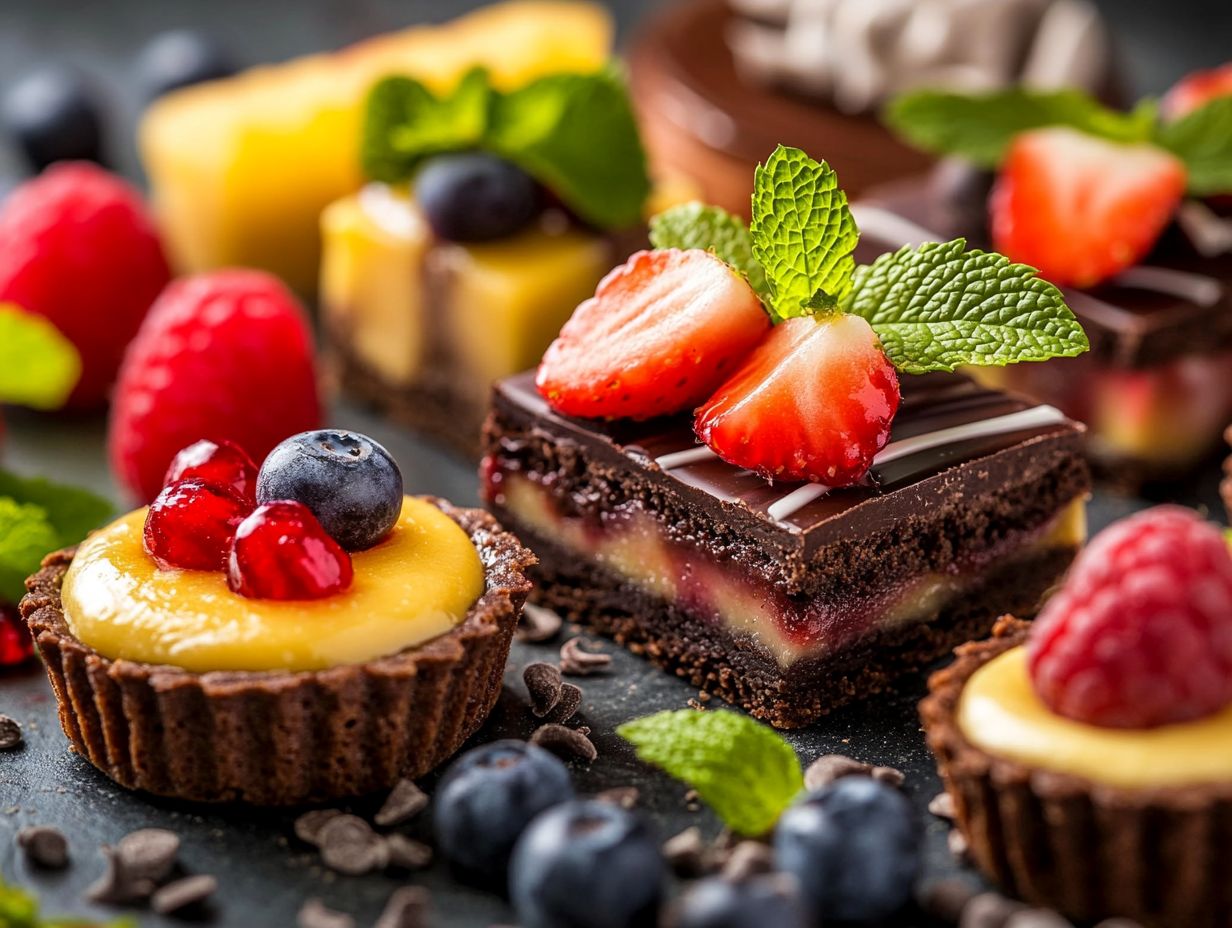
Exploring various cooking methods can truly elevate the flavor and texture of gluten-free desserts. Whether you’re baking, steaming, frying, or freezing, each technique offers unique results think softer textures or caramelized flavors. This allows you to indulge in a delightful array of gluten-free cakes, cookies, and even treats like gluten-free ice cream or tarts.
Baking typically imparts a light, airy quality to gluten-free cakes. This happens thanks to ingredients like almond flour or coconut flour that yield wonderfully moist outcomes. Conversely, steaming lends a tender, chewy texture, making it perfect for gluten-free dumplings or puddings.
If you’re in the mood for something indulgent, frying adds a delightful crispiness to desserts such as fritters or donuts, enhancing flavors with layers of crunch. Freezing techniques, especially for ice creams, allow for a beautiful fusion of flavors and creamy textures. This often results in a velvety mouthfeel that’s hard to resist.
Each method plays an important part in shaping the final product and defining the overall enjoyment of your gluten-free sweets.
Frequently Asked Questions
What is the main trick for making gluten-free desserts taste better?
The main trick for making gluten-free desserts taste better is to use alternative flours and ingredients that mimic the texture and flavor of gluten-containing ingredients, such as almond flour, coconut flour, and xanthan gum, which is a thickening agent used in gluten-free baking.
Can I use regular recipes and simply substitute gluten-free ingredients?
No, it is not recommended to simply substitute regular ingredients with gluten-free ones. Gluten-free baking requires specific methods and measurements to achieve the desired texture and taste.
Are there any specific types of gluten-free flour that work best for desserts?
Yes, several types of gluten-free flour work well for desserts, such as almond flour, coconut flour, and rice flour. Experiment with different types to find the ones that suit your taste preferences.
How can I add more flavor to my gluten-free desserts?
You can enhance the flavor of your gluten-free desserts by using natural sweeteners like honey or maple syrup. Additionally, adding spices like cinnamon or nutmeg, or incorporating fruits or nuts into your recipes can make a significant difference.
Yes, it is important to adjust the baking time and temperature when making gluten-free desserts. Generally, gluten-free treats require a slightly longer baking time at a lower temperature to prevent them from becoming dry or over-baked. Using an all-purpose gluten-free flour blend like Cup 4 Cup or Better Batter can help achieve a better texture.
Are there any other tips for making gluten-free desserts taste better and have great flavors?
Yes, you can also try using high-quality gluten-free ingredients, letting the batter rest before baking, and using non-stick or parchment-lined pans. These practices ensure your gluten-free desserts come out delicious and flavorful. Incorporating gluten-free vanilla, gluten-free almond flour, and gluten-free butter can enhance the taste and moistness.
For easy gluten-free dessert recipes, consider making gluten-free brownies, gluten-free cupcakes, or gluten-free chocolate chip cookies. Also, be mindful of cross-contaminated ingredients to ensure your desserts remain safe for those with Celiac Disease. Get ready to impress your friends and family with delicious gluten-free treats they won’t forget!


